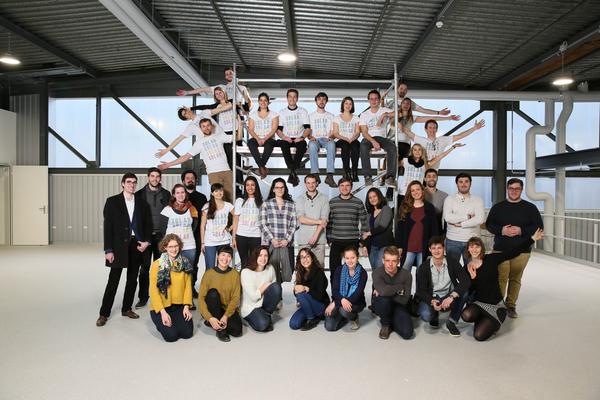Students imagine a social activator for the Solar Decathlon

© Swiss Living Challenge
A team of Swiss students was selected by the U.S. Department of Energy to compete in an international collegiate competition to build a solar-powered housing unit. For the Solar Decathlon, the students must design a full-scale, fully operational housing unit that uses sunlight as its sole energy source. The Swiss Team came up with a social activator concept to raise awareness and promote a more responsible and more local use of resources. The social activator prototype is also intended as a place for people to meet and exchange ideas and can be built in various neighborhoods. Groupe E is Diamond partenaire for the project.
A team of students from the Ecole Polytechnique Fédérale de Lausanne (EPFL), the School of Engineering and Architecture Fribourg (HEIA-FR / HES-SO), the University of Fribourg (UNIFR) and the Geneva University of Art and Design (HEAD / HES-SO) was selected by the U.S. Department of Energy (DOE) to compete in the Solar Decathlon 2017 to be held in the United States (exact date and venue not yet known). This competition has existed since 2002 and includes ten contests (hence the name decathlon). In order to win this competition, the Swiss team must score a maximum number of points in ten different contests, which include architecture, comfort, engineering, energy balance and communication.
A social activator
Jessica Ruffieux, one of the students on the Swiss Team, explains: « the fundamental question that we ask ourselves with this solar-powered housing unit is how it will help to change behavior patterns for more sustainable living. » The housing unit will be designed first and foremost as a community center, where people can meet (e.g. at the repair café).
« Recycling, repair, reuse, production of energy, consumption and smart use of resources. These are some of the principles that we wish to apply, demonstrate and convey, » continues Jessica. The solar-powered prototype will also promote non-motorized forms of transport by including the necessary facilities for this. « Biodiversity is another theme to be covered. The external surfaces will be designed in a way that favors local fauna and flora, » adds Axelle Marchon, also a student.
Multi-oriented roofing
Of course, the prototype is still in the design phase. However, several ideas are already taking shape. First of all, the team wishes to develop an architectural project that includes the technique from the outset. This interdisciplinary methodology is still relatively unheard of and the students would like to promote it. Therefore, the roofing will be angled in such a way as to optimize uniform energy production throughout the day. « This multi-oriented roofing requirement will influence the architectural shape, » explains Matias Cesari, student.
Wood!
Wood was chosen as the material for the prototype structure. « This is a resource available in Switzerland that is relatively light enough to be used and transported. It also offers great freedom of expression, » comments Baptiste Gex, another student on the Swiss Team. « The outer structure of the building will be put to maximum use. « We imagine it to be 100% productive, not just for solar energy but also as a food production source. We intend to create surfaces that can be used to grow vegetables. » « The housing unit must serve as a symbol, with a clear and easily recognizable visual identity, » adds Axelle.
The Swiss Living Challenge
The Swiss team decided to call the project the Swiss Living Challenge, in homage to the smart living lab, the new research center to develop housing units of the future. This research center is jointly run by the EPFL, HEIA-FR and UNIFR. The prototype will also be built in the experimental hall of the smart living lab, on the site of the blueFACTORY, an innovation park located in Fribourg.
After being exhibited at the Solar Decathlon 2017 in the United States, the housing unit will be transported back to Fribourg. It will have to be adaptable so that it can ideally blend into a nearby neighborhood. This pilot project is also intended to satisfy the needs of the Spatial Planning Act (SPA) by addressing the problem of densification of existing built-up areas. « Our prototype needs to be both modular and adaptable so that it can satisfy the requirements of different neighborhoods where it could be set up. Depending on the needs of local inhabitants, it might include such things as a childcare facility or a market for local products, » concludes Baptiste.
Very committed partners
Students still have 18 months to continue developing and building a full-scale, fully operational and entirely solar-powered 100-m2 prototype. The structure must be adaptable so that it can blend into the urban setting later on. Fifteen other collegiate teams will be presenting their projects at the Solar Decathlon 2017.
In order to ensure that this ambitious project runs smoothly, the students will receive guidance from experts from four great higher education institutions as well as support from institutional partners such as the Swiss Federal Office of Energy (SFOE) and the Canton of Fribourg.
The involvement of the private sector and industry in this project is crucial in terms of financial support, know-how and productive exchanges over the two-year co-creation period. Since its inception, the project has received constant support from Landolt & Cie as a Gold sponsor. Today, an agreement has been signed with Groupe E as a Diamond sponsor. It will therefore contribute its expertise to this project, which is very much aligned with its core activities.
All of the partners of the Swiss Living Challenge and more information can be found here: http://www.swiss-living-challenge.ch.
